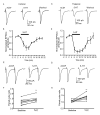Serotonin gating of cortical and thalamic glutamate inputs onto principal neurons of the basolateral amygdala
- PMID: 28899729
- PMCID: PMC5634953
- DOI: 10.1016/j.neuropharm.2017.09.013
Serotonin gating of cortical and thalamic glutamate inputs onto principal neurons of the basolateral amygdala
Abstract
The basolateral amygdala (BLA) is a key site for crossmodal association of sensory stimuli and an important relay in the neural circuitry of emotion. Indeed, the BLA receives substantial glutamatergic inputs from multiple brain regions including the prefrontal cortex and thalamic nuclei. Modulation of glutamatergic transmission in the BLA regulates stress- and anxiety-related behaviors. Serotonin (5-HT) also plays an important role in regulating stress-related behavior through activation of both pre- and postsynaptic 5-HT receptors. Multiple 5-HT receptors are expressed in the BLA, where 5-HT has been reported to modulate glutamatergic transmission. However, the 5-HT receptor subtype mediating this effect is not yet clear. The aim of this study was to use patch-clamp recordings from BLA neurons in an ex vivo slice preparation to examine 1) the effect of 5-HT on extrinsic sensory inputs, and 2) to determine if any pathway specificity exists in 5-HT regulation of glutamatergic transmission. Two independent input pathways into the BLA were stimulated: the external capsule to mimic cortical input, and the internal capsule to mimic thalamic input. Bath application of 5-HT reversibly reduced the amplitude of evoked excitatory postsynaptic currents (eEPSCs) induced by stimulation of both pathways. The decrease was associated with an increase in the paired-pulse ratio and coefficient of variation of eEPSC amplitude, suggesting 5-HT acts presynaptically. Moreover, the effect of 5-HT in both pathways was mimicked by the selective 5-HT1B receptor agonist CP93129, but not by the 5-HT1A receptor agonist 8-OH DPAT. Similarly the effect of exogenous 5-HT was blocked by the 5-HT1B receptor antagonist GR55562, but not affected by the 5-HT1A receptor antagonist WAY 100635 or the 5-HT2 receptor antagonists pirenperone and MDL 100907. Together these data suggest 5-HT gates cortical and thalamic glutamatergic inputs into the BLA by activating presynaptic 5-HT1B receptors.
Keywords: Basolateral amygdala; Glutamatergic transmission; Serotonin receptor.
Copyright © 2017 Elsevier Ltd. All rights reserved.
Figures





References
-
- Abrams JK, Johnson PL, Hollis JH, Lowry CA. Anatomic and functional topography of the dorsal raphe nucleus. Ann N Y Acad Sci. 2004;1018:46–57. - PubMed
-
- Asan E, Steinke M, Lesch KP. Serotonergic innervation of the amygdala: targets, receptors, and implications for stress and anxiety. Histochem Cell Biol. 2013;139:785–813. - PubMed
-
- Bombardi C. Distribution of 5-HT2A receptor immunoreactivity in the rat amygdaloid complex and colocalization with gamma-aminobutyric acid. Brain Res. 2011;1370:112–128. - PubMed
-
- Bonaventure P, Voorn P, Luyten WH, Jurzak M, Schotte A, Leysen JE. Detailed mapping of serotonin 5-HT1B and 5-HT1D receptor messenger RNA and ligand binding sites in guinea-pig brain and trigeminal ganglion: clues for function. Neuroscience. 1998;82:469–484. - PubMed
MeSH terms
Substances
Grants and funding
LinkOut - more resources
Full Text Sources
Other Literature Sources

